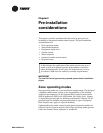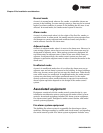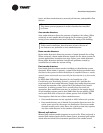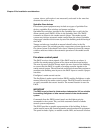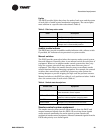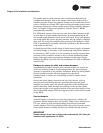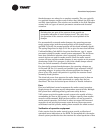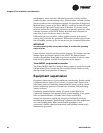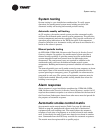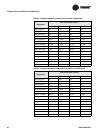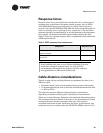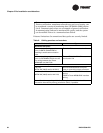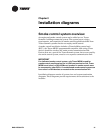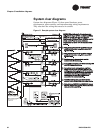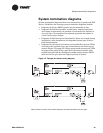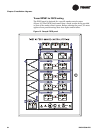
System testing
BAS-APG001-EN 27
System testing
System testing is a pre-installation consideration. To verify proper
operation, the smoke control system must include provisions for:
automatic weekly self-testing and manual periodic testing.
Automatic weekly self-testing
As UL requires, the smoke control system provides automated weekly
self-tests for dedicated smoke control system components. The self-tests
activate components and monitor operation. They provide verification of
operation status indications to the FSCS that show if the component
passed or failed the test. Automatic weekly self-tests do not function if a
smoke or fire alarm is present.
Manual periodic testing
As NFPA 92A (NFPA 2000, Recommended Practice for Smoke Control
Systems), chapter 5.4 requires, the smoke control system provides a
manual testing capability. It provides annual tests for nondedicated
system components and semi-annual tests for dedicated system
components. The semi-annual tests are required in addition to the
automated weekly self-tests for dedicated smoke control system
components. Building maintenance personnel schedule and conduct the
tests.
The manual periodic tests verify smoke control system responses to alarm
zone inputs. Some of the manual testing must be performed with the
system operating on emergency power, if applicable. An alarm must be
generated in each zone. The system and equipment responses must be
verified and recorded. Manual periodic testing should occur when the
building is not occupied.
Alarm response
Alarm response is a pre-installation consideration. NFPA 92A (NFPA
1996, Recommended Practice for Smoke Control Systems), section 3.4.5.5
requires the automatic response to an alarm to be based on the location of
the first alarm. Subsequent alarms from other zones must be ignored for
the purposes of automatic response.
Automatic smoke control matrix
An automatic smoke control matrix (Table 5 on page 28, dedicated;
Table 6 on page 28, nondedicated) shows each piece of mechanical
equipment and each building zone. The matrix shows the automatic
response of each piece of equipment to an initial alarm for each smoke
zone. It also shows the mode of each zone based on an alarm in another
zone. Commands from the FSCS may override the automatic responses.
The matrix must be engineered for a specific project.



